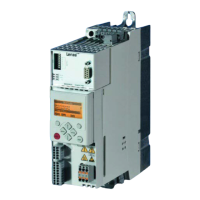8400 StateLine C | Reference manual
System bus "CAN on board"
Structure of the CAN data telegram
436 L Firmware ≤ 11.00 - DMS 8.0 EN - 10/2011
Node address (node ID)
Every node of the system bus network must be assigned to a node address (also called node
ID) within the valid address range (1 ... 127) for unambiguous identification.
Assigning a node address more than once within a network is impermissible.
The own node address can be configured via the DIP switches or via code C00350
.
Setting the node address
( 432)
Identifier assignment
The system bus is message-oriented instead of node-oriented. Every message has an
unambiguous identification, the identifier. For CANopen, node-oriented transfer is
achieved by the fact that every message has only one transmitter.
The basic identifiers for network management (NMT) and sync as well as the basic SDO
channel (SDO1) are defined in the CANopen protocol and cannot be changed.
In the Lenze setting, the basic identifiers of the PDOs are preset according to the
"Predefined connection set" of DS301, V4.02 and can be changed via
parameters/indexes if required. Identifiers of the process data objects
( 450)
1) If you set the sync transmit/receive identifier manually, observe the use of the emergency telegram, since it has the same
COB-ID.
Object Direction Lenze-Base-ID CANopen-Base-ID
from device to device dec hex dec hex
Network management (NMT) 0 0 0 0
Sync
1)
128 80 128 80
Emergency
1)
z 128 80 128 80
PDO1
(Process data channel 1)
TPDO1
z 384 180 384 180
RPDO1
z 512 200 512 200
PDO2
(Process data channel 2)
TPDO2
z 640 280 640 280
RPDO2
z 641 281 768 300
PDO3
(Process data channel 3)
TPDO3
z 768 300 896 380
RPDO3
z 769 301 1024 400
SDO1
(Parameter data channel 1)
TSDO1
z 1408 580 1408 580
RSDO1
z 1536 600 1536 600
SDO2
(Parameter data channel 2)
TSDO2
z 1472 5C0 1472 5C0
RSDO2
z 1600 640 1600 640
Heartbeat z 1792 700 1792 700
Boot-up z 1792 700 1792 700

